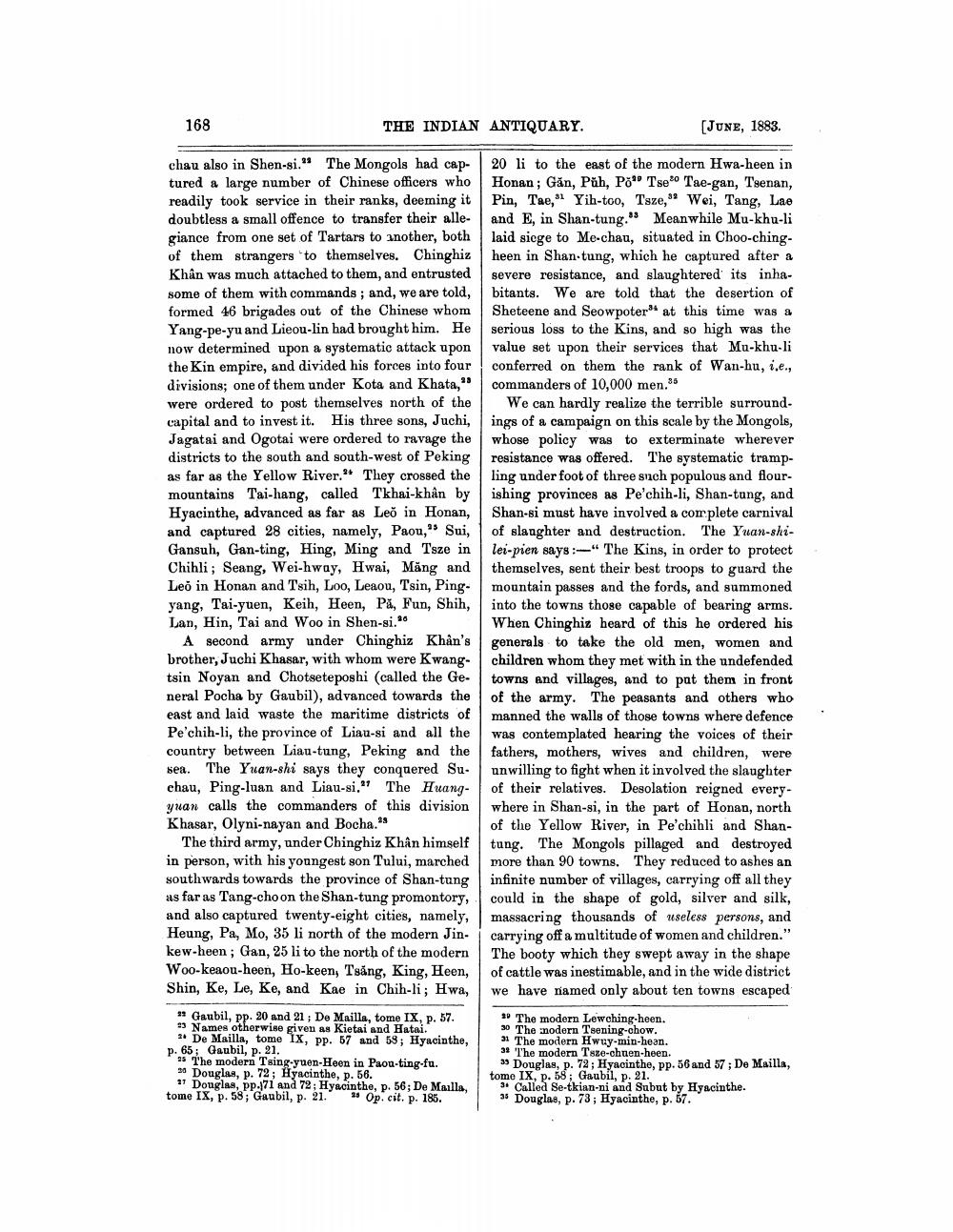________________
168
THE INDIAN ANTIQUARY.
[JUNE, 1883.
chau also in Shen-si." The Mongols had cap- tured a large number of Chinese officers who readily took service in their ranks, deeming it doubtless a small offence to transfer their allegiance from one set of Tartars to another, both of them strangers to themselves. Chinghiz Khân was much attached to them, and entrusted some of them with commands; and, we are told, formed 46 brigades out of the Chinese whom Yang-pe-yu and Lieou-lin had brought him. He now determined upon a systematic attack upon the Kin empire, and divided his forces into four divisions; one of them under Kota and Khata," were ordered to post themselves north of the capital and to invest it. His three sons, Juchi, Jagatai and Ogotai were ordered to ravage the districts to the south and south-west of Peking as far as the Yellow River. They crossed the mountains Tai-hang, called Tkhai-khân by Hyacinthe, advanced as far as Leo in Honan, and captured 28 cities, namely, Paou," Sui, Gansuh, Gan-ting, Hing, Ming and Tsze in Chihli; Seang, Wei-hway, Hwai, Măng and Leo in Honan and Tsih, Loo, Leaou, Tsin, Pingyang, Tai-yuen, Keih, Heen, PX, Fun, Shih, Lan, Hin, Tai and Woo in Shen-si.
A second army under Chinghiz Khân's brother, Juchi Khasar, with whom were Kwang- tsin Noyan and Chotseteposhi (called the Ge. neral Pocha by Gaubil), advanced towards the east and laid waste the maritime districts of Pe'chih-li, the province of Liau-si and all the country between Liau-tung, Peking and the sea. The Yuan-shi says they conquered Su. chau, Ping-luan and Liau-si." The Huangyuan calls the commanders of this division Khasar, Olyni-nayan and Bocha.es
The third army, under Chinghiz Khân himself in person, with his youngest son Tului, marched southwards towards the province of Shan-tung as far as Tang-cho on the Shan-tung promontory, and also captured twenty-eight cities, namely, Heung, Pa, Mo, 35 li north of the modern Jinkew-heen; Gan, 25 li to the north of the modern Woo-keaou-heen, Ho-keen, Tsang, King, Heen, Shin, Ke, Le, Ke, and Kae in Chih-li; Hwa,
20 li to the east of the modern Hwa-heen in Honan; Găn, Puh, Po" Tseo Tae-gan, Tsenan, Pin, Tae Yih-too, Tsze," Wei, Tang, Lae and E, in Shan-tung. Meanwhile Mu-khu-li laid siege to Me-chau, situated in Choo-chingheen in Shan-tung, which he captured after a severe resistance, and slaughtered its inhabitants. We are told that the desertion of Sheteene and Seowpoter at this time was a serious loss to the Kins, and so high was the value set upon their services that Mu-khu-li conferred on them the rank of Wan-hu, i.e., commanders of 10,000 men.85
We can hardly realize the terrible surroundings of a campaign on this scale by the Mongols, whose policy was to exterminate wherever resistance was offered. The systematic trampling under foot of three such populous and flourishing provinces as Pe'chih-li, Shan-tung, and Shan-si must have involved a complete carnival of slaughter and destruction. The Yuan-shilei-pien says:-" The Kins, in order to protect themselves, sent their best troops to guard the mountain passes and the fords, and summoned into the towns those capable of bearing arms. When Chinghiz heard of this he ordered his generals to take the old men, women and children whom they met with in the undefended towns and villages, and to pat them in front of the army. The peasants and others who manned the walls of those towns where defence was contemplated hearing the voices of their fathers, mothers, wives and children, were unwilling to fight when it involved the slaughter of their relatives. Desolation reigned everywhere in Shan-si, in the part of Honan, north of the Yellow River, in Pe'chihli and Shantung. The Mongols pillaged and destroyed more than 90 towns. They reduced to ashes an infinite number of villages, carrying off all they could in the shape of gold, silver and silk, massacring thousands of useless persons, and carrying off a multitude of women and children." The booty which they swept away in the shape of cattle was inestimable, and in the wide district we have named only about ten towns escaped
12 Gaubil, pp. 20 and 21 ; De Mailla, tome IX, p. 57. 93 Names otherwise given as Kietai and Hatai.
3* De Mailla, tome 1x, pp. 57 and 58; Hyacinthe, p. 65; Gaubil, p. 21.
as The modern Tsing-yuen-Heen in Paon-ting-fu. 30 Douglas, p. 72; Hyacinthe, p. 56.
* Douglas, pp.171 and 72: Hyacinthe, p. 56; De Mailla, tome IX, p. 58; Gaubil, p. 21. * Op. cit. p. 185.
30 The modern Lewching heen. 30 The nodern Teening-chow. 31 The modern Hwuy-min-hean. 31 l'he modern Tsze-chuen-heen. 33 Douglas, p. 72; Hyacinthe, pp. 56 and 57 ; De Mailla, tomo IX, p. 58; Gaubil, p. 21.
3. Called Se-tkian-ni and Subut by Hyacinthe. 35 Douglas, p. 73; Hyacinthe, p. 57.




